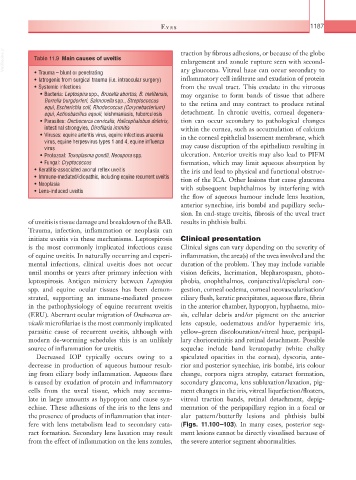Page 1212 - Equine Clinical Medicine, Surgery and Reproduction, 2nd Edition
P. 1212
Eyes 1187
VetBooks.ir Table 11.9 Main causes of uveitis traction by fibrous adhesions, or because of the globe
enlargement and zonule rupture seen with second-
ary glaucoma. Vitreal haze can occur secondary to
• Trauma – blunt or penetrating
• Iatrogenic from surgical trauma (i.e. intraocular surgery) inflammatory cell infiltrate and exudation of protein
• Systemic infections from the uveal tract. This exudate in the vitreous
• Bacteria: Leptospira spp., Brucella abortus, B. melitensis, may organise to form bands of tissue that adhere
Borrelia burgdorferi, Salmonella spp., Streptococcus to the retina and may contract to produce retinal
equi, Escherichia coli, Rhodococcus (Corynebacterium)
equi, Actinobacillus equuli, leishmaniasis, tuberculosis detachment. In chronic uveitis, corneal degenera-
• Parasites: Onchocerca cervicalis, Halicephalobus deletrix, tion can occur secondary to pathological changes
intestinal strongyles, Dirofilaria immitis within the cornea, such as accumulation of calcium
• Viruses: equine arteritis virus, equine infectious anaemia in the corneal epithelial basement membrane, which
virus, equine herpesvirus types 1 and 4, equine influenza
virus may cause disruption of the epithelium resulting in
• Protozoal: Toxoplasma gondii, Neospora spp. ulceration. Anterior uveitis may also lead to PIFM
• Fungal: Cryptococcus formation, which may limit aqueous absorption by
• Keratitis-associated axonal reflex uveitis the iris and lead to physical and functional obstruc-
• Immune-mediated/idiopathic, including equine recurrent uveitis tion of the ICA. Other lesions that cause glaucoma
• Neoplasia
• Lens-induced uveitis with subsequent buphthalmos by interfering with
the flow of aqueous humour include lens luxation,
anterior synechiae, iris bombé and pupillary seclu-
sion. In end-stage uveitis, fibrosis of the uveal tract
of uveitis is tissue damage and breakdown of the BAB. results in phthisis bulbi.
Trauma, infection, inflammation or neoplasia can
initiate uveitis via these mechanisms. Leptospirosis Clinical presentation
is the most commonly implicated infectious cause Clinical signs can vary depending on the severity of
of equine uveitis. In naturally occurring and experi- inflammation, the area(s) of the uvea involved and the
mental infections, clinical uveitis does not occur duration of the problem. They may include variable
until months or years after primary infection with vision deficits, lacrimation, blepharospasm, photo-
leptospirosis. Antigen mimicry between Leptospira phobia, enophthalmos, conjunctival/episcleral con-
spp. and equine ocular tissues has been demon- gestion, corneal oedema, corneal neovascularisation/
strated, supporting an immune-mediated process ciliary flush, keratic precipitates, aqueous flare, fibrin
in the pathophysiology of equine recurrent uveitis in the anterior chamber, hypopyon, hyphaema, mio-
(ERU). Aberrant ocular migration of Onchocerca cer- sis, cellular debris and/or pigment on the anterior
vicalis microfilariae is the most commonly implicated lens capsule, oedematous and/or hyperaemic iris,
parasitic cause of recurrent uveitis, although with yellow–green discolouration/vitreal haze, peripapil-
modern de-worming schedules this is an unlikely lary chorioretinitis and retinal detachment. Possible
source of inflammation for uveitis. sequelae include band keratopathy (white chalky
Decreased IOP typically occurs owing to a spiculated opacities in the cornea), dyscoria, ante-
decrease in production of aqueous humour result- rior and posterior synechiae, iris bombé, iris colour
ing from ciliary body inflammation. Aqueous flare change, corpora nigra atrophy, cataract formation,
is caused by exudation of protein and inflammatory secondary glaucoma, lens subluxation/luxation, pig-
cells from the uveal tissue, which may accumu- ment changes in the iris, vitreal liquefaction/floaters,
late in large amounts as hypopyon and cause syn- vitreal traction bands, retinal detachment, depig-
echiae. These adhesions of the iris to the lens and mentation of the peripapillary region in a focal or
the presence of products of inflammation that inter- alar pattern/butterfly lesions and phthisis bulbi
fere with lens metabolism lead to secondary cata- (Figs. 11.100–103). In many cases, posterior seg-
ract formation. Secondary lens luxation may result ment lesions cannot be directly visualised because of
from the effect of inflammation on the lens zonules, the severe anterior segment abnormalities.

